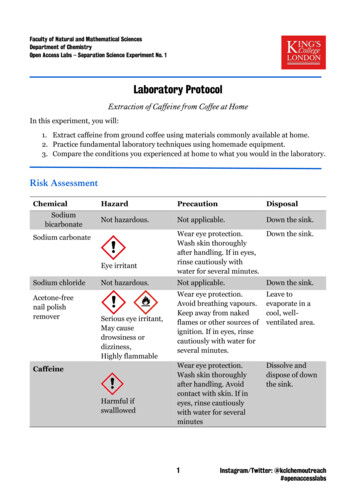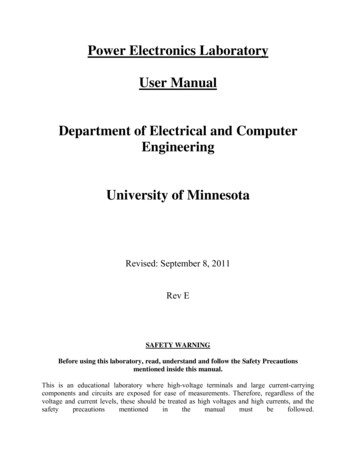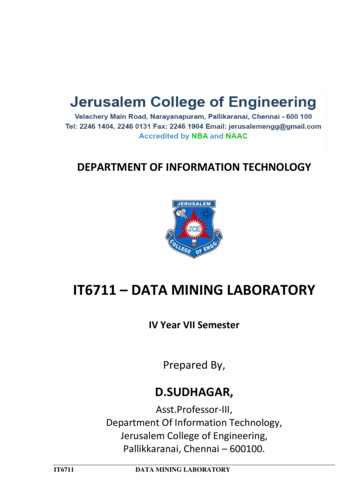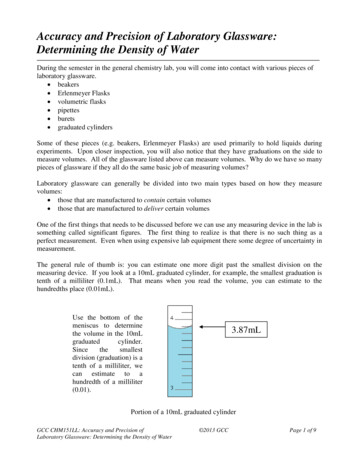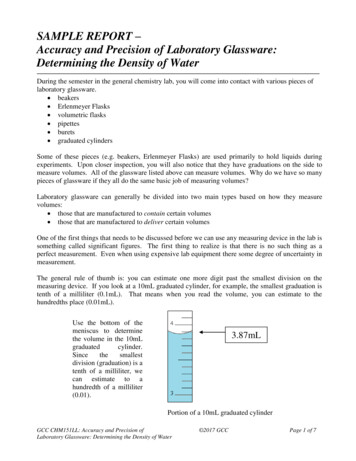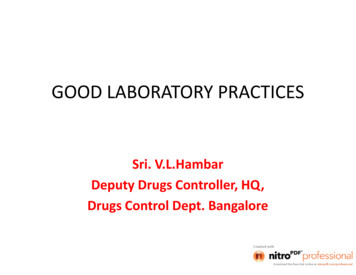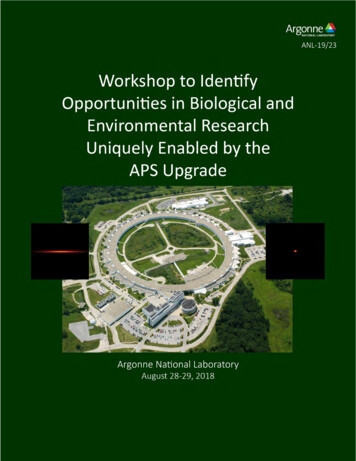
Transcription
About Argonne National LaboratoryArgonne is a U.S. Department of Energy laboratory managed by UChicago Argonne, LLCunder contract DE-AC02-06CH11357. The Laboratory’s main facility is outside Chicago,at 9700 South Cass Avenue, Lemont, Illinois 60439.For information about Argonne and its pioneering science and technology programs, see www.anl.gov.DOCUMENT AVAILABILITYOnline Access: U.S. Department of Energy (DOE) reports produced after 1991 and agrowing number of pre-1991 documents are available free via DOE's SciTech Connect(http://www.osti.gov/scitech/)Reports not in digital format may be purchased by the public from the NationalTechnical Information Service (NTIS):U.S. Department of CommerceNational Technical Information Service5301 Shawnee RdAlexandra, VA 22312www.ntis.govPhone: (800) 553-NTIS (6847) or (703) 605-6000Fax: (703) 605-6900Email: orders@ntis.govReports not in digital format are available to DOE and DOE contractors from the Office ofScientific and Technical Information (OSTI):U.S. Department of EnergyOffice of Scientific and Technical InformationP.O. Box 62Oak Ridge, TN 37831-0062www.osti.govPhone: (865) 576-8401Fax: (865) 576-5728Email: reports@osti.govDisclaimerThis report was prepared as an account of work sponsored by an agency of the United States Government. Neither theUnited States Government nor any agency thereof, nor UChicago Argonne, LLC, nor any of their employees or officers,makes any warranty, express or implied, or assumes any legal liability or responsibility for the accuracy, completeness, orusefulness of any information, apparatus, product, or process disclosed, or represents that its use would not infringeprivately owned rights. Reference herein to any specific commercial product, process, or service by trade name, trademark,manufacturer, or otherwise, does not necessarily constitute or imply its endorsement, recommendation, or favoring by theUnited States Government or any agency thereof. The views and opinions of document authors expressed herein do notnecessarily state or reflect those of the United States Government or any agency thereof, Argonne National Laboratory, orUChicago Argonne, LLC.On the cover: Center image: Aerial view of the Advanced Photon Source (APS) at Argonne National Laboratory.Insets: Simulated x-ray beam source profiles, comparing the beam from the APS today (left) to the beam from anupgraded APS storage ring (right) with an APS Upgrade multi-bend achromat lattice.
Workshop to Identify Opportunities inBiological and Environmental ResearchUniquely Enabled by the APS UpgradeAugust 28-29, 2018Organizing CommitteeOlga Antipova, APS/ANLSi Chen, APS/ANLKenneth Kemner, ANLStefan Vogt, APS/ANLInvited ParticipantsVanessa Bailey, PNNLZhonghou Cai, APS/ANLZoe Cardon, MBLFrancesco De Carlo, APS/ANLShi-you Ding, Michigan State U.Kamel Fezzaa, APS/ANLZou Finfrock, CLSBob Fischetti, APS/ANLMatthew Fields, Montana State U.Ted Flynn, ANLRobin Graham, ANLMarie-Francoise Gros, ANLDean Haeffner, APS/ANLEllery Ingall, Georgia TechJoseph Jakes, Forest Products LaboratoryAndrzej Joachimiak, APS/ANLJulie Jastrow, ANLSteve Heald, APS/ANLNancy Hess, PNNLRao Kotamarthi, ANLBarry Lai, APS/ANLPeter Larsen, ANLJohn Magyar, CaltechLee Makowski, Northeastern U.Jörg Maser, APS/ANLSabeeha Merchant, UC BerkeleyKarolina Michalska, ANLPhilippe Noirot, ANLEd O’Loughlin, ANLHugh O’Neill, SNS/ORNLRachel Shahan, Duke U.Darren Sherrell, ANLStephen Streiffer, APS/ANLPam Weisenhorn, ANL
Table of ContentsExecutive Summary . 1The Advanced Photon Source and the Advanced Photon Source Upgrade . 6Grand Challenges in the Biological and Environmental Sciences . 9Cell Structure . 9Cell Chemistry . 15Environmental Microbiology and Biogeochemistry . 19Soil Structure and Chemistry . 25Atmospheric Science . 32DOE User Facilities as Models, and Collaboration . 34
Executive SummaryThe development of synchrotron-based x-ray science has enabled tremendous scientific advances,driven both by discoveries of new fundamental ways to derive insight from the interaction of x-rays withmatter and by the evolution of x-ray light sources themselves. Over the last 20-plus years, the U.S.Department of Energy’s (DOE’s) Advanced Photon Source (APS) at Argonne has yielded a multitude oftransformational insights into science questions across numerous areas relevant to the biological,geological, geochemical, biogeochemical, and environmental sciences.Recent developments in accelerator technology, particularly the multi-bend achromat lattice, have ledto plans to dramatically upgrade the APS, allowing an upgraded APS to offer orders-of-magnitudeimprovements in key parameters such as coherence and brightness, while retaining high-energycapabilities. These enhanced parameters are directly relevant to almost all hard x-ray imaging,scattering, and spectroscopy experiments (Eriksson et al., 2014). The APS Upgrade Project exceedsthe capabilities of today’s synchrotrons by 2 to 3 orders of magnitude in brightness and coherent flux inthe hard x-ray range, enabling a transformational range of new probes for the structure, properties, andfunctionality of matter. With vastly improved coherent flux, nearly all techniques can becomemicroscopies. For example, frontiers inaccessible today will be opened by x-ray instruments thatprovide three-dimensional (3-D) real-space resolution down to nanometers across, up to millimeters offield of view, providing the ability to follow in real time relevant processes and trace element sensitivitydown to a few atoms. In addition to the unprecedented spatial resolution across a large field of view,and with appropriate time resolution, the ability for high-throughput, four-dimension/five-dimension datacollection enables unprecedented statistical analysis of complex biological and environmental systemsin changing environments.A workshop to identify “Opportunities in Biological and Environmental Research Uniquely Enabled bythe APS Upgrade” took place at Argonne on August 28-29, 2018. An emphasis of the workshop was anexploration of how imaging and microscopy experiments enabled by the APS-U will be most relevantfor biological and environmental research. One of the goals of the workshop was to identify some of theopportunities for compelling biological and environmental research that will be enabled by an upgradedAPS. Participants worked to identify synchrotron-based approaches at the APS and APS-U that wouldhelp them address their critical research questions. In addition, participants worked to identify improvedor new synchrotron approaches provided by the APS-U that could help address their critical researchquestions. A final goal of the workshop was to articulate the role the upgraded APS can play inbiological and environmental research within the context of other DOE user facilities and capabilitiesthroughout the U.S. These include the Environmental Molecular Science Laboratory, the SpallationNeutron Source, numerous electron microscopy centers, other x-ray light sources, and DOE highperformance computation facilities that are already serving the biological and environmental researchcommunities.A sister workshop on “Biological Science Opportunities Provided by the APS Upgrade” was organizedat Argonne to explore the biological science opportunities offered by the unique new capabilities of theAPS-U and how the broad structural biology community can best exploit them and a workshop report(https://bit.ly/2xcYUrF) describes the conclusions from that workshop in great detail. The APS-Uenables routine serial macromolecular crystallography as well as microbeam experiments ideally suitedto study soluble proteins (Meents et al., 2017) and membrane proteins (Martin-Garcia et al., 2017), aswell as study of protein dynamics, which today require a free-electron laser (Mizohata et al., 2017).Finally, participants in both workshops recognized that the use of the APS-U to addressmacromolecular x-ray crystallography science provides part of the continuum of spatial and temporalscales needed to enable investigations of biological and environmental science questions from the sub-1
nanometer to centimeter spatial scales and the sub-picosecond and longer temporal scales (seeTable 1).Table 1. Key complex system features, the spatial resolution required to observe them, and their importance toaccelerating scientific discovery in the biological and environmental sciences.ResolutionFeature/ProcessUtility0.1-500 nmMineral surface, mineral-microbe interface, mineral-root interface,aerosols, organo-mineral associations, C species, nutrientspecies, other elements, cellular and subcellular structure (cellwalls, internal cell structure), cellular and subcellular biochemistry,pore chemistry, waterReactive transport,thermodynamicmodels0.5-10 μmBacterium, hyphae, mycorrhizae, microsites, pore chemistry,biofilms, organo-mineral complexes, pore connections/throats,plant-microbe environments, waterProcess-rich models,microbially-explicitmodels0.01 mm-2 mmColonies, roots, aggregate hierarchy, detritus, redox fronts, porenetworks, waterMicrobiomeinvestigations, input toecosystem models0.2 mm-5 cmPlant physiology, wetting fronts, root networks, soil columnfeatures, redox fronts, waterGeneralizableprinciples, input tolocal, regional modelsAttendees at this workshop identified many biological and environmental thematic research areas thatwould benefit from the projected 500-1000-times increase in x-ray brilliance of the APS-U. Attendeesalso identified specific key research questions in each of those thematic research areas that presentlyare not easily addressable, but could be addressed by using the high brilliance of the APS-U hard x-raybeams. Integrated and collaborative brainstorming sessions among workshop participants withbiological science expertise, environmental science expertise, or x-ray physics expertise enabledidentification of the specific roles different x-ray measurements could play in addressing these criticalresearch questions.Without exception, all workshop participants expressed great confidence and excitement in the role thatthe APS currently plays in their respective research areas and the role that the APS-U will play. Belowis a short summary of the biological and environmental theme areas workshop participants identified asbenefitting from the APS-U. More detailed discussions of each of these biological and environmentalresearch areas, key questions that are addressed by the APS-U, and the specific means by which theAPS-U will be used to advance the science are presented later in this report.Cell StructureDefining the relationship between structural organization and emergent properties is fundamental tounderstanding the function of complex biomolecular systems, critical for modifying or re-engineeringthese systems, and necessary for designing and synthesizing systems that exhibit novel properties.Lignocellulosic biomass is primed to play a major role in our future bio-economy by providing woodbased building materials and as a renewable resource for biorefineries producing chemicals, fuel, andenergy. Challenges include characterization of the multi-scale organization of structural elements inlignocellulosic biomass and linking multi-scale organization to mechanical, chemical transport, thermal,moisture-induced swelling/shrinking, and acoustic properties. Synchrotron x-ray structuralcharacterization techniques (e.g., x-ray diffraction, ptychography, and transmission x-ray computedtomography) used in conjunction with in situ moisture chambers are already revealing new information2
about the moisture swelling/shrinking in wood-based materials. Similarly, in biorefineries, the productionof fuels and chemicals depends on diffusion of deconstruction chemicals into cell walls, in addition totransport of depolymerization products out of cell walls. Along with ptychographic and transmissiontomography imaging, scanning x-ray microdiffraction is a promising new approach that has the potentialto provide detailed information about the molecular-to-nanoscale architecture of these tissues.Cell ChemistryAlthough the first-row transition metals of the Periodic Table of Elements are critical in terms ofenabling the chemistry of life, they are minor in terms of biomass. Understanding homeostatic control oftrace-metal assimilation, utilization, and sequestration are required for new discoveries with respect tofundamental pathways of metal metabolism and are broadly applicable in biology. For example, themetalloproteins associated with microorganisms play an important role in the oxidation of methane gas,which is an important greenhouse gas with a 20-year global warming potential 84 times that of CO2.Beyond microorganisms, the cellular chemistry of higher organisms, such as plants, is critical forunderstanding controls on biomass production for agricultural, chemical, and fuel production. Scanningprobe x-ray fluorescence microscopy and ptychography approaches in 3-D, coupled with x-rayabsorption spectroscopy approaches with nanometer spatial resolution to understand the spatialorganization of chemistries within cells, are critical for advancing our understanding of cell function. Inaddition, the higher throughput of these measurements enabled by the increased brilliance of the APSU enables a statistical analysis of the cell-to-cell variations of chemistries within them. Finally, thevisualization of larger fields of view enabled by the increased brilliance of the APS-U provides highspatial resolution (10 nm) investigation of the organizational structure within organelles without theneed for sectioning the organelles typically required by other imaging modalities.Environmental Microbiology and BiogeochemistryMicroorganisms inhabit nearly every environment on Earth, living in complex communities forming anetwork of integrated metabolisms that drive the biogeochemical cycles of major (hydrogen, carbon,nitrogen, and oxygen) and many minor elements (e.g., phosphorous, sulphur, manganese, and iron).These coupled processes play a critical role in major ecosystem processes including the assimilation ofcarbon, the mineralization of organic matter and accompanying release of CO2, the formation andoxidation of CH4, uptake and release of nutrients (e.g., nitrogen and phosphorous), and the availabilityand transformations of contaminants. Development of a robust and predictive understanding of coupledbiogeochemical processes and cycles requires a comprehensive knowledge of the chemical speciationand spatial organization of the elements of interest in a system and the processes controlling masstransfer. Chemical speciation information is critical for defining how biological behavior, abiotic-bioticinteractions, and molecular transformation control the reactivity and mobility of contaminants (e.g.,uranium, technetium, and mercury), nutrients (e.g., nitrogen, phosphorous, and carbon), and criticalbiogeochemical elements (e.g., sulphur, iron, and manganese). The spatial organization and structureof heterogeneous microenvironments can greatly impact the biogeochemical properties within air,aquatic, and terrestrial systems. Given the ubiquity of these complex biotic and abiotic microenvironments, techniques are needed that can characterize the chemistry within them. By providing anorders-of-magnitude increase in coherence and brilliance, the APS-U provides the ability to imagethese microenvironments with larger fields of view, in 3-D, and with the higher spatial resolution than ispossible today. In addition, the APS-U enables a statistical analysis of the variations of microenvironment function within critical environmental systems.Soil Structure and ChemistrySoil is a remarkably complex biomaterial that exists as a dynamic, structured, self-organized but highlyheterogeneous mixture of mineral particles, organic matter, water, air, and countless living organisms.Soil organic matter exists as a continuum of decay products of varying size, composition, and position3
within the soil matrix. The spatial organization of these components (i.e., soil structure) is dynamic andlinked to environmental processes such as wetting/drying, soil mineralogy and chemical interactions,organic matter decomposition, and the biophysical actions of living plant roots and soil biota. Thecontrols on soil hydrobiogeochemical cycles and their intimate coupling with plant productivity are at thecore of Earth’s life-support systemsCurrently, micron- and pore-scale soil environmental properties affecting the stabilization, priming, andmineralization of soil organic matter are not explicitly considered in Earth system models. A critical butunresolved question is to what extent these small-scale phenomena must be considered to improve thepredictive power of Earth system models as climate change occurs. For instance, relatively smallchanges in soil organic matter dynamics and storage could have a large impact on the global carboncycle, and subsequent cycling of water and nutrients. Some of the critical questions in soil science thatneed to be addressed include: What is the spatial/temporal heterogeneity of soil organic mattercomposition and its relation to the soil mineral matrix and structure? What physical, chemical,biological, and environmental factors control the transformation of carbon and nutrients and watermovement within soil?Spatially resolved 3-D chemical and structural information of soil would be extraordinarily valuable forunderstanding nutrient cycling in soil, maintenance of soil fertility and water retention within soils,carbon storage in soils, and the dynamic co-control of biogeochemistry by microbial catalysis anddiffusive/advective delivery of substrates within soils.The orders-of-magnitude increase in coherence and brilliance provided by the APS-U provides greaterfields of view (millimeter to centimeter) with increased spatial resolution ( 10 nm) for 3-D imaging of thestructure and chemical properties of soils. The increased brilliance of the APS-U also enables thedevelopment of x-ray Raman measurement approaches that can be useful for measuring carbonchemistries within bulk and hydrated soils. Combined use of all of these developments can providecritical information about 3-D pore size/shape-connectivity/soil organic matter-inclusions within soil, 3-Dwater flow paths and water location with soil, and 3-D organic carbon and microbial distribution withinsoils, particularly associated with plant roots and minerals.Atmospheric and Aerosol ResearchAtmospheric aerosol particles have significant impacts on air quality and visibility, public health,biogeochemistry, and climate change. A key challenge in understanding the uncertainties related toincreasing greenhouse gases and aerosols is closely tied to their interactions with clouds. Presently,investigation of the nanometer-scale structure and chemical interactions of aerosols and theirinteractions with clouds is very difficult. In addition, statistical classification of aerosol samples ishampered by the reduced number of samples that can be analyzed. The development of a cloudchamber at the upgraded APS-U for imaging aerosols can enable the investigation of aerosol-clou
Center image: Aerial view of the Advanced Photon Source (APS) at Argonne National Laboratory. Insets: Simulated x-ray beam source profiles, comparing the beam from the APS today (left) to the beam from an upgraded APS storage ring (right) with an


